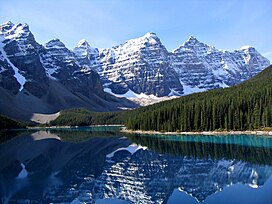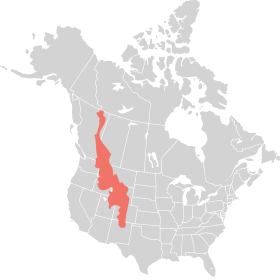The Rocky Mountains (often called The Rockies) are a range of mountains in the western United States and Canada. They stretch from the northernmost part of British Columbia, in western Canada, to New Mexico, in the southwestern United States. Part of the mountain range in Colorado is a national park, called Rocky Mountain National Park. The Rocky Mountains are more than 3,000 miles long (4,800 kilometers). The highest point in the Rocky Mountains is Mount Elbert. Mount Elbert is 14,433 ft tall (4,401m).
| Rocky Mountains | |
|---|---|
| The Rockies (en), Les montagnes Rocheuses (fr), Montañas Rocosas, Rocallosas (es) | |
 Moraine Lake and the Valley of the Ten Peaks, Banff National Park, Alberta, Canada | |
| Highest point | |
| Peak | Mount Elbert, Colorado |
| Elevation | 14,440 feet (4401.2 m)[1] |
| Coordinates | 39°07′03.9″N 106°26′43.2″W / 39.117750°N 106.445333°W |
| Dimensions | |
| Length | 4,828 km (3,000 mi)(straight-line distance) |
| Width | 650 km (400 mi) |
| Area | 777,000 km2 (300,000 sq mi)[2] |
| Geography | |
| Countries |
|
| Provinces/States | |
| Range coordinates | 43°44′28″N 110°48′07″W / 43.741°N 110.802°W |
| Parent range | North American Cordillera |
| Geology | |
| Age of rock | Precambrian and Cretaceous |
| Type of rock | |
The Rocky Mountains are relatively new, formed from 55 million to 80 million years ago (mya) during the Laramide orogeny. North America began to move westwards as Pangaea broke up. A number of tectonic plates began to slide under the North American plate. The angle of subduction was shallow, resulting in a broad belt of mountains running down western North America. Since then, further tectonic activity and erosion by glaciers has sculpted the Rockies into dramatic peaks and valleys.
The rocks in the Rocky Mountains were formed long before the mountains were raised. The oldest rock is Precambrian metamorphic rock that forms the core of the North American continent. There is also Precambrian sedimentary argillite, dating back to 1.7 billion years ago. During the Paleozoic, western North America lay underneath a shallow sea, which deposited many kilometers of limestone and dolomite.[3]
In the southern Rocky Mountains, near present-day Colorado, these ancestral rocks were disturbed by mountain building about 300 mya, during the Pennsylvanian. This mountain building produced the ancestral Rocky Mountains. They consisted largely of Precambrian metamorphic rock forced upward through layers of the limestone. The limestone had been laid down in a shallow sea.[4] The mountains eroded throughout the late Paleozoic and early Mesozoic, leaving extensive deposits of sedimentary rock.
References
change- ↑ "MOUNT ELBERT". NGS data sheet. U.S. National Geodetic Survey.
- ↑ "Rocky Mountains, or Rockies". Encyclopædia Britannica Kids.
- ↑ Gadd, Ben (2008). "Geology of the Rocky Mountains and Columbias" (PDF). Archived (PDF) from the original on 2012-04-20. Retrieved 2010-01-01.
- ↑ Chronic, Halka (1980). Roadside Geology of Colorado. ISBN 0-87842-105-X.
